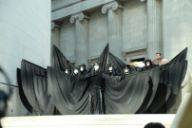Artwashing
All the facets of war that the Trojan narratives represent, have proven to be relevant throughout the centuries that followed. In the line of Trojan reception, the protest of BP or not BP might be one of the most recent translations. Lots of translations preceded the protest in the British Museum, as were exhibited in the BP exhibition Troy: myth and reality. Artworks spanning the last five centuries showed the interest in and relevance of the Trojan Wars. One of the Trojan stories that has been translated many times in the last decades, is the story of Trojan Women. Although the narrative was not told in the epic works of Homer or Vergil, it has made its way into the canon of Troy, this time by the ancient playwrights Euripides and Seneca. The story focuses on the aftermath of the Trojan War, in particular on the horrors endured by some of the Trojan women that were taken captive by the Greek Ulysses. Cassandra, the priestess of Apollo who prophesizes the future but is believed by none, is taken away by Agamemnon as his concubine, only to find herself awaiting death when Agamemnon’s wife Clytaemnestra finds out. Helen, who supposedly was the reason for the conflict in the first place, is not granted freedom after being taken by Paris and falls back into the hands of Menelaus. Andromache, already having lost her husband Hector, must endure the double pain of her son Astyanax being thrown off the city walls, and of her sister Polyxena being sacrificed to appease the ghost of Achilles.
These stories inspired a group of thirteen Syrian women who, having been exiled to Jordan, performed their own rendition of Trojan Women, laying bare the innumerable similarities between the ancient Trojan war and the Syrian civil war, called Queens of Syria. Just like the Trojan women, they had lost loved ones, had suffered great harm, and had to abandon their lives because of the consequences of war. The performance became an outcry against the war they had experienced first-hand. Maha left her home on the day she gave birth, fearing for the life of her children because of increased bombing. For three months she camped in a nearby building, when a car bomb next to the building exploded, forcing her and her family to abandon their hometown. Reham’s wedding party was cancelled because tanks rolled through the streets, shortly after which her cousin was taken captive, mutilated and murdered. Her husband was hiding behind a freezer in his supermarket when a tank pointed its launcher at their building. They left the same day, leaving behind everything they had just built up as a newly-wed couple.
Lift up your head from the dust! Heave up from the earth the weight of your misery, you whom the Gods have cursed. Some agonies are beyond telling, and some must be told.(Text from play Queens of Syria)
The baffling stories pile up and bring the consequences of war excruciatingly close. A film adaptation of Queens of Syria was part of the Troy exhibition in the British Museum. The film was exhibited proudly between other modern interpretations of the Trojan narratives, but also stirred up more criticism of BP’s affiliation with this exhibition. Together with BP or not BP, director of Queens of Syria Zoe Lafferty confronted the British Museum on the use of the play to accommodate an exhibition that contributes to BP’s programme: “That puts us in a position that that artwork is now being used by an oil and gas multinational company to help artwash what they’re doing, which is also contributing to climate crisis, refugee crisis, war.” The fact that BP is sponsoring the spread of the anti-war message Queens of Syria is sending whilst contributing to the refugee-crisis themselves, is peak level irony.
One of the performances by BP or not BP in the British Museum on the 8th of February, focused on the issues of using Queens of Syria. A group of women, fully dressed in black garments, stood in various formations on the main stairs of the museum. They were carrying large sticks with black flags attached which fluttered around their bodies like wings. All their movements, including their descent from the stairs, were solemnly slow. Once they came closer, their stern faces were revealed, fully painted in silver and black. About fifteen minutes later, they left the entrance of the museum with an enormous crowd of people either interested in what was next, or aware of the symbolic meaning they intended to convey. They led the procession along the Trojan horse, off the premises and into the rest of London. The conceptual nature of their performance hid any overt political message, but their garments and solemnity bore a striking resemblance to the Queens of Syria. Leaving the museum with a throng of supporters conveyed that the artwork Queens of Syria does not belong in an exhibition sponsored by a company that contributes to the refugee crisis.


